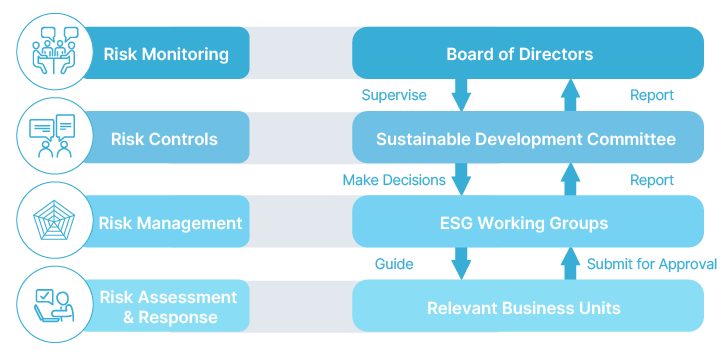Protecting the Environment / Climate-Related Financial Disclosures
Climate-Related Financial Disclosures
Climate Governance Frameworks
Following the introduction of the TCFD framework in 2021, WNC added its signature to the TCFD official website in 2022. WNC has gradually adjusted its organizational structure for sustainability governance and clearly defined the responsibilities of senior managers. The BOD is the highest supervisory unit for sustainability, and the Sustainable Development Committee reports the progress of sustainability related initiatives to the BOD on a regular basis. In addition, the Committee compiles overall strategies for sustainability and supervises senior managers’ governance status and their performance of key indicators.
The Environmental Protection, Social Responsibility, and Corporate Governance working groups under the Committee review the status of each ESG project every quarter, develop goals in accordance with WNC’s sustainable development directions and strategies, and establish related management guidelines and specific action plans. Furthermore, to enhance WNC’s management capabilities regarding climate and nature-related risks and ensure the implementation of management actions, the Sustainability Development Center coordinates with relevant business units to establish a climate and nature-related risk management team. This team identifies and assesses risks and opportunities the company may face, evaluates potential financial impacts and formulates management policies and carbon management initiatives.
For details about WNC’s TCFD, please refer to WNC’s 2024 TCFD & TNFD Report.

Climate Risks Identification, Assessment and Management
WNC’s Climate Risk Assessment Team conducts a comprehensive review every three years and annually monitors the status of risk management. The team also considers emerging domestic and international industry issues and global trends to ensure the relevance and comprehensiveness of the risk assessment. With external experts, the Sustainability Development Center considered eight categories of risks and the upstream, midstream, and downstream areas of the value chain to establish a climate-related issue list. An internal risk identification questionnaire was designed, and business units, facility affairs, industrial safety, general affairs, finance, DMIS, legal, QA, mechanical and industrial design, industry research, supply chain management, and sustainability units were invited to participate. These units, based on their expertise and experience, conducted workshop discussions on risk probability and the severity of impact, and formulated corresponding management policies and action plans for major risks.
Climate Goals
In response to the Paris Agreement and the goal of limiting global warming to 1.5 °C above pre-industrial levels, WNC adopted the SBTi methodology in 2023 to set science-based carbon reduction targets. We commit to reducing Scope 1 and Scope 2 GHG emissions by 42% by 2030, compared to the 2022 baseline, and Scope 3 emissions by 25% compared to the 2023 baseline. We also aim to achieve net-zero emissions across all scopes by 2050. These targets were approved by the SBTi in February 2025. WNC also joined RE100 in 2023, committing to using 100% renewable energy by 2040. By aligning with international climate initiatives, WNC aims to improve its response to climate change.
To achieve net-zero targets and meet carbon reduction requirements, WNC has implemented the ISO 50001 Energy Management System. The company promotes energy-saving initiatives across five key systems: production processes, lighting, exhaust, air conditioning, and compressed air to enhance energy use efficiency and reduce Scope 1 and 2 emissions. In 2024, WNC executed 82 energy-saving projects, estimated to save 27,076 GJ of electricity—equivalent to a reduction of 4,088.26 metric tons of CO2e. WNC also monitors developments in carbon credits and negative emission technologies both domestically and internationally. To support its net-zero goals, the company pursues carbon credits through afforestation and other carbon reduction projects that provide additional environmental benefits.
In terms of internal carbon pricing, WNC references TCFD transition risk analysis, considering factors such as domestic and international carbon taxes, renewable energy procurement, and investments in energy-efficient equipment. These insights guide the company’s internal carbon pricing strategy. To strengthen internal understanding, WNC hosted benchmark companies at its 2024 ESG Good Ideas competition to share experiences in carbon pricing. WNC introduced an internal carbon price of USD $30 per metric ton of CO2e. This pricing supports net-zero efforts, greenhouse gas management (Scopes 1, 2 and 3), equipment procurement decisions, evaluation of carbon offset or capture investments, and compliance with evolving regulations.
In 2025, WNC continues working with external experts to conduct training sessions and optimize its internal carbon pricing strategies and implementation.
